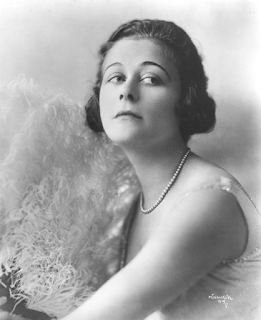Frances Marion: One of the First Hollywood Screenwriters
Over half the scripts
written during Hollywood’s silent era were written by women. The women came
from a variety of backgrounds when they entered the industry. Some were actors,
some came from Broadway and others started off as journalists, to name a few
professions. Largely unknown to a modern film audience, Frances Marion was one
of the first well established and sought-after screenwriters in American
cinema. During the 1910s to late 1930s, she penned many scripts for films that
are now considered classics. She wrote across many genres and even received
academy awards for The Big House
(1930) and The Champ (1931).
Born on the 18th
of November 1888, in San Francisco, her parents named her Marion Benson Owens. She
would later be inspired and take her screen credit from famous American Civil
War soldier Frances Marion. She started out as a journalist, model, career
artist and World War I correspondent before eventually moving to Los Angeles.
Marion’s Hollywood career
began in the early 1910s when she was hired as a writing and general assistant
at Lois Weber Productions. The company was started by Florence Lois Weber,
herself a pioneering film director. It was here that Marion learnt about the
film industry and honed her script writing skills.
Written with Anita Loos,
her first screenplay was The New York Hat
(1912). It was directed by the legendary D. W. Griffith and starred the day’s
most well-known actress Mary Pickford. The experience was great exposure for
Marion and started a powerhouse partnership (and friendship) with Pickford.
Marion and Pickford had
similar mindsets and worked extremely well together. Director and acquaintance
Clarence Brown noted their strong chemistry and compared their ability to
create new material together as being “spontaneously combustible”. It wasn’t
long before they became close friends and regularly spent time together outside
of work. Pickford soon hired Marion as her exclusive writer. Some of their
greatest collaborations include The
Little Princess (1917), Rebecca of
Sunnybrook Farm (1917), Stella Maris
(1918) and Pollyanna (1920).
On the production of The Poor Little Rich Girl (1917), Marion
and Pickford were creating comedy material that clashed with director Maurice
Tourneur’s vision. He felt the subject material was too dark in nature to make
funny. But because Pickford was the star and had creative authority, Tourneur’s
objections were overruled. Based on a play by Eleanor Gates, the story follows
a young girl – Gwen (played by Pickford) – in a middle-class family who is
lonely and unwanted. Her parents make no time for her and the housing staff,
who are responsible for Gwen’s wellbeing, push her around and abuse her.
Producers were also not happy with the film’s final cut and thought it was in
their best interests not to release it. Marion was distraught that she had possibly
destroyed Pickford’s career. The two campaigned, the producers gave in and the
film was distributed. It was a success and was responsible for Pickford’s trend
of playing young children in comedy roles. She was twenty-four when she played
11-year-old Gwen.
By the 1920s, Marion was
one of the most popular Hollywood screenwriters with a string of hits to her
name. She was the highest paid screenwriter earning $3000 a week (no figures in
this article have been adjusted for inflation), an astronomical amount never
heard of before in the industry at the time. Marion gained critical acclaim for
Stella Dallas (1925) and The Son of the Sheik (1926). She even had a hand in directing with Just Around the Corner (1921), The Love Light (1921) and The Song of Love (1923).
Marion retired from
screenwriting in the late 1930s. She was disillusioned by the state of
Hollywood screenwriting and described it as “like writing on sand with the wind
blowing”. She found it very restrictive in its rigid, structured approach. At
this stage in her career, she had written over 100 scripts and won countless
awards. She wrote Pickford’s last starring film, Secrets (1933), before Pickford retired from acting to focus on
producing. Their partnership had lasted nearly twenty years. In 1937, Marion
wrote one of the first guides on American screenwriting, How to Write and Sell Film Stories. The book was taught as part of
the film curriculum at the University of South California.
Marion spent her later
years writing stage plays and novels. She passed away in 1972. Her academy
award winning script, The Champ, was
remade in 1979 and starred Jon Voight and Faye Dunaway. Marion will be played
by Julia Stiles in an upcoming Mary Pickford biopic, The First (2017).
By: Matthew J. Healy
Sources:
Frances Marion – Biography.com
(https://www.biography.com/people/frances-marion-214110)
Frances Marion – IMDB
(http://www.imdb.com/name/nm0547966/)
Profile - Frances Marion (https://wfpp.cdrs.columbia.edu/pioneer/ccp-frances-marion/)
Julia Stiles To Play Scribe
Frances Marion In Mary Pickford Pic ‘The First’
(http://deadline.com/2013/01/julia-stiles-frances-marion-mary-pickford-the-first-418595/)
The Poor Little Rich Girl:
Mary Pickford and her wordsmith.
(https://trueclassics.net/2012/06/03/the-poor-little-rich-girl-mary-pickford-and-her-wordsmith/)
This Forgotten Female
Screenwriter Helped Give Hollywood Its Voice
(http://time.com/4186886/frances-marion/)







Comments
Post a Comment